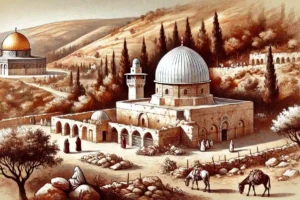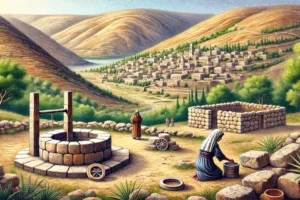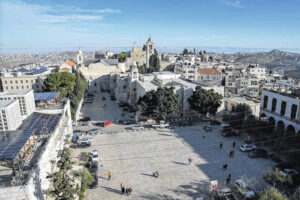
Jacob’s Well: A Nexus of History and Faith
Jacob’s Well is a historically and biblically significant site mentioned in the Gospel of John. It is where Jesus spoke with the Samaritan woman, offering her “living water” and revealing Himself as the Messiah.
Quick Facts:
- Location: Jacob’s Well is located in the city of Nablus in the West Bank, historically known as Shechem in Samaria.
- Biblical Reference: The well is most famously referenced in John 4:5-6, where Jesus meets the Samaritan woman.
- Depth and Structure: Historically, the well was noted for its depth, significant enough to require a rope and a bucket to draw water.
- Religious Significance: For Christians, Jacob’s Well represents a site of deep spiritual meaning, symbolizing the living water (eternal life) that Jesus offers.
- Architectural Developments: Over centuries, various structures have been built over the well, including a series of churches. The current structure is the Greek Orthodox Church of St. Photina, built in the 19th century.
- Pilgrimage Site: The well continues to be a pilgrimage site for Christians, attracting visitors from around the world who seek to experience its historical and spiritual significance.
Jacob’s Well is located in Nablus (ancient Shechem), within the West Bank. It is historically and biblically significant, known particularly from the New Testament narrative in the Gospel of John. This site has been revered through the ages, not only because of its mention in the Bible but also due to its associations with Old Testament patriarch Jacob, who, according to tradition, purchased the land and dug the well.
Theological and Historical Insights:
- Biblical Narrative: The well is prominently featured in John 4, where Jesus converses with the Samaritan woman. This passage is rich in theological symbolism, particularly the contrast between physical and spiritual thirst. Jesus’ offer of “living water” symbolizes the eternal life and satisfaction found in Him, distinguishing it from the temporary relief of physical water.
- Archaeological Significance: Jacob’s Well is authenticated by its continuous mention throughout history and its unchanging geographic location. It is considered one of the most authentic and revered holy sites in Christian tradition. The well itself is deep, with reports varying about its exact depth due to debris accumulation over centuries.
- Religious Symbolism: In Christian theology, the well symbolizes the depth and longevity of God’s provisions for humanity. The living water offered by Jesus at this site becomes a metaphor for the salvation and spiritual nourishment provided by Christ.
- Site Developments: Over time, Jacob’s Well has seen several constructions built over it, intended to protect the site and accommodate pilgrims. The most notable current structure is the Greek Orthodox Church of St. Photina, built in the 19th century, which enshrines the well. St. Photina (the Orthodox name for the Samaritan woman) is venerated as a saint, and the church serves as a place for liturgy and pilgrimage.
- Pilgrimage and Veneration: The site continues to draw pilgrims from around the world, offering a tangible connection to the biblical story. Pilgrims often seek to draw water from the well, echoing the actions of the Samaritan woman and seeking a personal experience of the spiritual message of the site.
- Interfaith Importance: Situated in a region marked by religious diversity and historical conflicts, Jacob’s Well also represents a place of interfaith engagement. The well’s significance to Christian, Jewish, and even Samaritan traditions underscores its broader cultural and religious importance.
Conclusion: Jacob’s Well stands as a profound symbol in Christian spirituality, embodying themes of salvation, eternal life, and divine sustenance. Its historical continuity, archaeological authenticity, and theological depth make it a significant site for study, pilgrimage, and reflection. The well’s enduring presence and the narratives surrounding it offer rich insights into Christian theology, the life of Jesus, and His interactions with individuals and communities.



